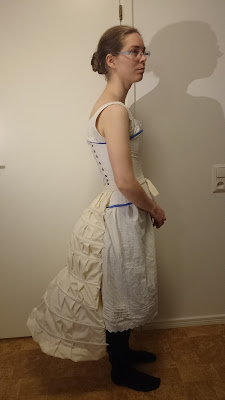In my previous post, I wrote about my research of early natural form skirt supports.
This is what I ended up making. I will not go into details of how I made them, but just show the result, and the HSM facts.
As mentioned in the earlier post, I based my bustle and petticoat on these ones:
I chose to make the gathering in the form of a drawstring, because I then can let them out and use the petticoat for bustle dress if I want. I think I have read something on how women would convert their bustle fashion petticoats to the later slimmer fashion by adding a drawstring like that, but I am not sure where I read it. I used the same pattern as I will use for the skirt - Skirt with train from Francis Grimbles Fashion of the Gilded Age (this book is a fantastic collection of period patterns and texts on the natural form era, but as it starts 1877, it could not entirely help me with the transitional fashions of 1876.) My petticoat closely reassembles the one made by Lisha Vidler at Yesterday's Thimble, and she made a very good tutorial (which I did not follow due to laziness), so for details on how to make one properly, look at her tutorial.
The bustle is just made up, without any attempt at period correctness or even neatness. I just made channels, and experimented with the length of each bone until I got the shape I wanted. This is the result:
Worn with this one underneath:
The Historical Sew Monthly Facts:
Challenge: Protection
What is it? Petticoat (and bustle) for the transition between early bustle and natural form.
Why is it protection? The train of the petticoat will protect the skirt train from dirt from the ground.
Year? 1876. Will work for other years by adjusting the width of the back with the drawstring.
Pattern? I used the Skirt with train from the book Fashion of the
Gilded Age by Frances Grimble, and added drawstrings in the back panel
to adjust width, and the flounce. For bustle - none, just made it up.
Fabric? Bedsheets, plain cotton for flounce, and mysteroius white fabric from stash for bustle
Notions: tapes, synthetic whalebone for bustle
Time? Maybe 5 h for petticoat, 4 h for bustle. Plus lots of hours to figure out which model of petticoat and bustle to use.
Cost? Bedsheets from linen cupboard. 80 kr for the flounce fabric.
How historically correct is it? Petticoat is based on a period pattern, and
pictures from ads from the time, so the look and shape is ok.
Construction methods are not- I did whatever I felt was easiest, as I
had not much inspiration/energy left for making after all the
researching. Also, I am sure that someone affluent enough to wear a long
train like this would have had fancier fabric than this in her
petticoat. And there seems to be lace on almost all petticoat flounces I
have seen, but I skipped that for cost reasons.
Bustle is decent in the resulting shape, but no attempts are made at using historically accurate materials or construction methods.
First worn: just for photos, yet.
I learned a lot in figuring out these ones - a fun challenge!




Inga kommentarer:
Skicka en kommentar